This article briefly outlines the cryptocurrency payment sector while focusing on how PayFi iterates within this space, gradually exploring its future development direction.
Written by: James Zhu
TL;DR
- The stablecoin market continues to grow, and cryptocurrency payments will not completely replace traditional fiat currency systems.
- The true significance of PayFi lies in promoting the application and innovation of crypto assets in real-world scenarios.
- Solana is not necessarily the only option for PayFi or the cryptocurrency payment sector; Ton Network and Sui, with their respective advantages, are likely to catch up.
- The future potential of the PayFi sector is immense, as a composite innovative application across multiple sectors, with a potential market value that could exceed ten billion dollars.
In recent years, the cryptocurrency payment sector has been continuously iterating and developing, transitioning from the initial perception of cryptocurrency payments as tools for gray market transactions to the current scenario where traditional fintech platform Stripe acquires the stablecoin platform Bridge, and industry giants like Paypal and Visa are entering the field. The emergence of the new concept of PayFi has sparked widespread attention.
To better understand the prospects of this sector, ArkStream has outlined the cryptocurrency payment sector while focusing on how PayFi iterates within this space, gradually exploring its future development direction.
Cryptocurrency Payment Sector
Since the birth of Bitcoin in 2008, it has transitioned from small-scale transactions among tech enthusiasts to widespread commercial applications accepted by global merchants, and now to regulatory intervention and compliance development, forming a diversified and platform-based payment ecosystem. Today, with the maturity of technology and the expansion of application scenarios, cryptocurrency payments are gradually integrating into the traditional financial system, providing users with more efficient, low-cost, high-transparency, and decentralized payment solutions, heralding a new round of transformation in the fintech field.
Behind this innovation, stablecoins serve as a bridge connecting cryptocurrencies and fiat currencies, providing a foundation for the widespread application of cryptocurrency payments through stable value storage and efficient on-chain circulation. By studying the stablecoin market, we can gain valuable insights into the entire market.
Overview of the Stablecoin Market
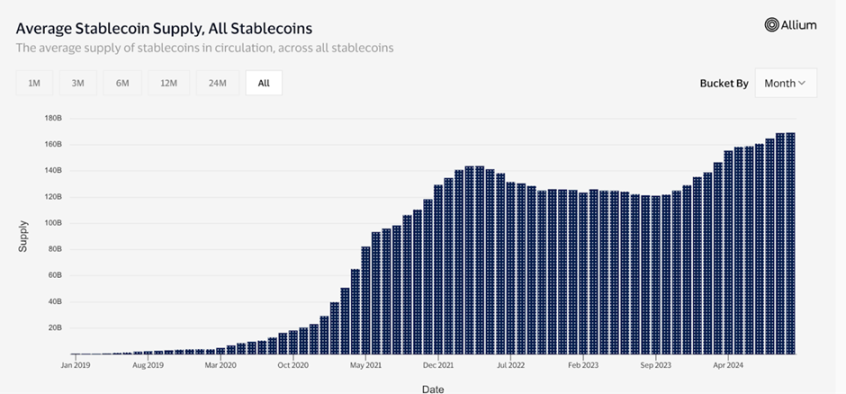
https://visaonchainanalytics.com/
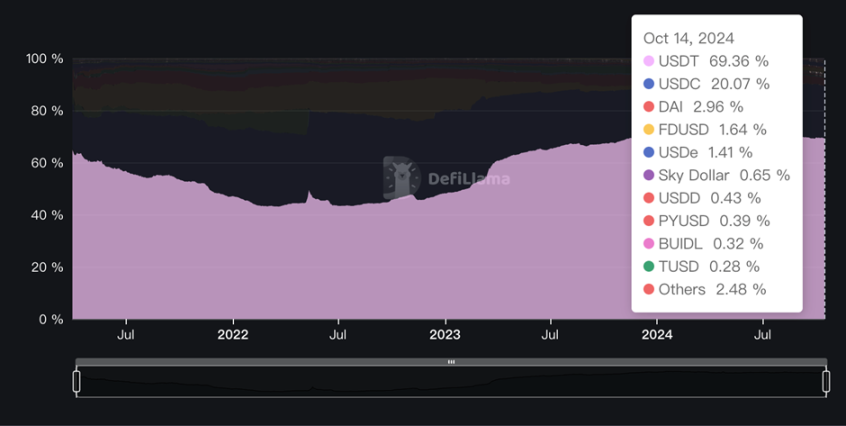
https://defillama.com/stablecoins
There is no doubt that the popularity of cryptocurrency payments is directly linked to the stablecoin market. These two charts (total supply of stablecoins and their respective market shares) reflect the long-term growth of stablecoin supply globally. USDT and USDC, as the two giants of stablecoins, account for 90% of the total market, with USDT being the undisputed leader (70% market share) and showing a stable, slow upward trend.
At the same time, we investigated the on-chain distribution of USDT and USDC, finding that USDT is issued across 13 chains.
Among these, the issuance on Torn is the largest, accounting for over 50%, followed by Ethereum and Solana, with the top four chains accounting for nearly 99% of the total issuance. In contrast, USDC's distribution is more concentrated, with nearly 92% of its total issuance on Ethereum, followed by Solana, Torn, and Polygon.
The conclusion is clear: ETH and Solana are currently the mainstream application scenarios for stablecoins. The continuous growth of the stablecoin sector, combined with the entry of several traditional payment industry leaders, sufficiently proves that the cryptocurrency payment sector has initially established a 'payment scale' operational system, directly demonstrating market recognition of the application scenarios for stablecoin payments.
To better understand the operational mechanism of cryptocurrency payments, we will analyze the four-layer architecture of cryptocurrency payment solutions, which ensures the security, scalability, and user experience of cryptocurrency payments.
Cryptocurrency Payment Solutions
In cryptocurrency payment solutions, the architecture consists of four layers:
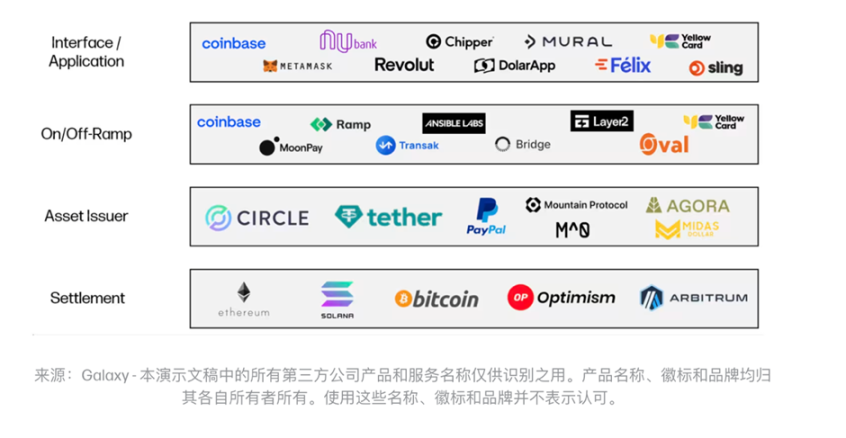
https://www.galaxy.com/insights/perspectives/the-future-of-payments/
- Settlement Layer: The underlying infrastructure of the blockchain, including various Layer 1 and general Layer 2 solutions like Optimism and Arbitrum, which differ slightly in speed, scalability, privacy, and security, but essentially sell block space.
- Asset Issuance Layer: Responsible for creating, maintaining, and redeeming stablecoins, aiming to maintain stable value against fiat currencies or a basket of pegged assets. Issuers profit by investing in stable income assets like government bonds, and unlike intermediaries in traditional payments, asset issuers do not charge fees for each transaction using their stablecoins. Once a stablecoin is issued on-chain, it can be self-custodied and transferred without paying any additional fees to the asset issuer.
- Deposit and Withdrawal Layer: Deposit and withdrawal providers act as a bridge between the blockchain and fiat currencies, serving as a technical link between stablecoins on the blockchain and fiat systems and bank accounts. These are mainly divided into B2C and C2C platforms.
- Interface / Application Layer: Platforms provide a software interface for customers, supporting cryptocurrency payments and leveraging the traffic generated from front-end transaction volumes as a business model.
Current State of the Cryptocurrency Payment Sector
- Traditional Payment Giants Entering Crypto
With the annual expansion of the cryptocurrency market and the approval of ETFs, traditional payment giants and crypto-native payment projects are actively developing and expanding related businesses. Visa expanded the settlement function of USDC to Solana as early as 2023, providing a more efficient solution for cross-border payments and real-time settlements.
Combining the previously introduced four-layer architecture of cryptocurrency payments, Visa builds its cryptocurrency payment ecosystem through multi-layered cooperation:
- In the asset issuance layer, Visa collaborates with Circle to use USDC as a stablecoin for settlement, ensuring stable and compliant payments.
- In the deposit and withdrawal layer, Visa supports users in transferring funds between fiat and cryptocurrencies through a partnership with Crypto.com.
- In the application layer, Visa provides options for USDC settlement to acquiring institutions like Worldpay and Nuvei, ensuring merchants can flexibly handle cryptocurrency payments.
- In the settlement layer, Visa has chosen Solana as its blockchain infrastructure, leveraging its high parallel processing capabilities, stable and predictable transaction fees, and fast block confirmation times for more efficient on-chain settlements.
Through this integration, Visa no longer relies solely on traditional banking settlement systems. This integration means users can directly settle using USDC through the blockchain network, eliminating intermediaries, shortening settlement times, and reducing costs. This move not only demonstrates how cryptocurrency payments can innovate the traditional payment system but also provides new ideas for the future global payment network.
Paypal has also chosen Solana as the new public chain for its PYUSD payments this year and is actively promoting blockchain-based payment methods. Paypal's vice president has repeatedly emphasized Solana's performance in high throughput and low latency, making it an ideal infrastructure for cryptocurrency payments. Although these traditional payment giants may not understand blockchain technology and the crypto industry as well as Web3-native payment players, they are quickly entering the cryptocurrency payment market to capture market share, leveraging their large user bases and traditional industry resources.
- Native Crypto Projects
In contrast to these traditional giants, native crypto payment projects are driving business development through more innovative approaches. Here, we have compiled statistics on crypto payment projects within the Binance exchange.
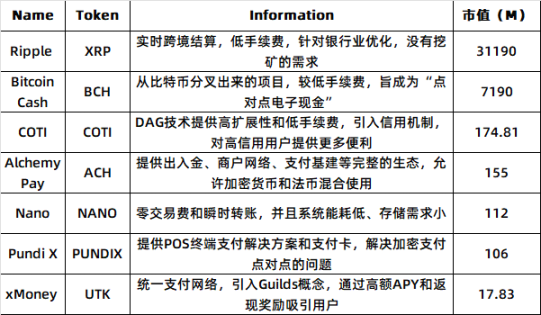
- Ripple for B2B Cross-Border Transactions
Ripple has raised nearly $300 million to date, with backers including well-known venture capital firms like a16z, Pantera, Polychain, and IDE. Currently, there are nearly 6 million active accounts, with over 300 partner institutions distributed across 50 different countries.
XRP is the native token of the Ripple Network, which focuses on the B2B market and aims to build a CBDC ecosystem in collaboration with banks worldwide through a decentralized payment settlement and asset exchange platform.
Ripple uses the RPCA consensus algorithm, and its RippleNet is built on the XRP Ledger, providing various solutions including xCurrent, xVia, and xRapid, aimed at improving the efficiency and liquidity of cross-border fund transfers. Through these technologies, Ripple collaborates with traditional financial institutions such as Bank of America and Credit Suisse. Compared to the traditional SWIFT system, Ripple has significant advantages in transaction speed and cost, completing transactions in seconds for less than 1% of the cost of traditional cross-border payments.
Statistics show that XRP payment users conduct approximately 150,000 transactions daily, with an average daily active user count of over 10,000. However, its development has not been smooth, having faced a multi-year SEC lawsuit accusing it of issuing securities without registration. Only recently did the SEC withdraw its lawsuit against Ripple.
- Alchemy Pay for Cryptocurrency Payments
Alchemy Pay has raised $10 million from investors such as DWF and CGV, recently gaining public attention again due to its virtual card collaboration with Samsung Pay.
Alchemy Pay has built a hybrid payment architecture that combines on-chain and off-chain elements by integrating underlying payment protocols like the Lightning Network, state channels, and Raiden Network. The on-chain component is responsible for ledger management and data storage, while the off-chain component handles verification, reconciliation, and other computation-intensive tasks. This architecture supports Alchemy Pay in providing customized solutions, including deposit and withdrawal payment services, rapid NFT purchases, cryptocurrency credit cards, and cryptocurrency payments.
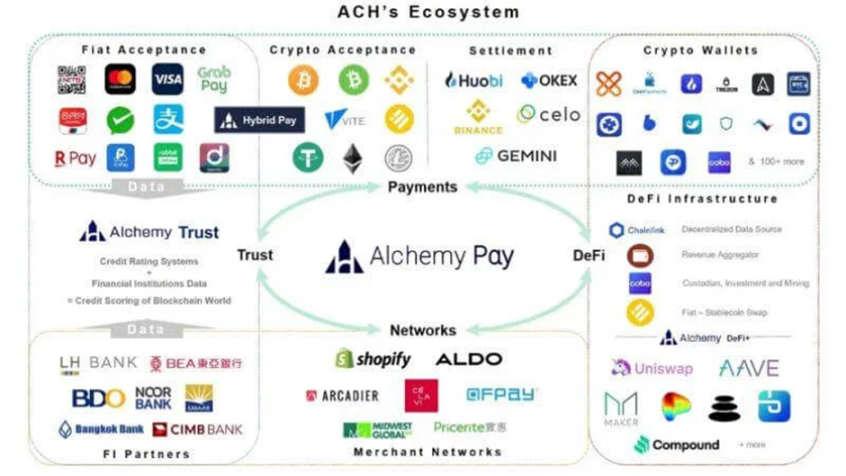
https://alexablockchain.com/alchemy-pay-to-transform-crypto-payment-with-its-new-product/
According to a third-party organized ACH ecosystem diagram, Alchemy Pay's ecosystem connects four major sectors: payments, merchant networks, DeFi, and trusted assets. Its partners include industry leaders such as Binance, Shopify, Visa, and QFPay, highlighting its extensive layout in the entire payment chain.
The biggest difference from XRP is that Alchemy Pay's token ACH is not used as a medium for cryptocurrency transactions, but rather provides cashback rewards to users with each payment, offering a consumption reward mechanism similar to traditional credit cards, empowering real payment scenarios and enhancing user loyalty.
ArkStream believes that whether traditional industry giants leverage their deep industry resources and global business networks to enter the crypto market or crypto-native payment projects utilize their decentralized architecture and token economic models, both types of players are driving industry development in different ways. Traditional giants possess strong market influence and compliance advantages, while crypto-native projects excel in technological innovation and rapid iteration. Recently, we witnessed Stripe completing the largest acquisition in crypto history by acquiring Bridge, and we look forward to both sides joining forces to fully leverage the traditional industry's capabilities in resource integration and scalable operations, combined with the innovative mechanisms of crypto, to advance the entire payment industry towards digitization and cost reduction.
- Pain Points in the Cryptocurrency Payment Sector
Unstable Transaction Costs: The original intention of cryptocurrency payments was to reduce intermediaries and transaction costs in traditional payment processes, but in practice, their fees are not cheaper than traditional payments. Network fees often spike during peak transaction periods, especially with congestion issues on major public chains. In contrast, traditional payment tools like credit cards or third-party payment platforms have more stable rates, and many daily transaction fees are borne by merchants (similar to the theory of free shipping), making them less perceptible to users and easier to accept.
Limited Processing Capacity: While the decentralization and consensus mechanisms of blockchain ensure system transparency and security, they also significantly limit the network's processing capacity. Since blockchains require consensus among global nodes, transaction speed is constrained by block capacity and block time. Although Layer 2 scaling solutions (like the Lightning Network), more efficient cross-chain communication, and sharding technologies may bring new breakthroughs, even the currently proven high-performance Solana's maximum TPS is still difficult to compare with traditional payment giants like Visa. For high-frequency, small-value payment scenarios, the current cryptocurrency payment networks still face significant bottlenecks.
Lack of Application Scenarios: Although cryptocurrency payments can already facilitate basic daily consumption, transfers, and cross-border payments, many common business scenarios in mature financial market environments, such as lending, insurance, leasing, crowdfunding, and asset management, still rely on traditional financial systems, leaving a complete void in cryptocurrency payment market share.
ArkStream believes the fundamental reason lies in the fact that the iteration of existing technologies and the application of products in the crypto space often prioritize the interests of existing users within the crypto domain, neglecting broader market demands. Whether it is Alchemy or Visa, their focus on blockchain remains on deposits and withdrawals, crypto debit cards, and crypto peer-to-peer payments. To achieve mass adoption, ArkStream believes project teams need to pay attention to user demands outside the crypto ecosystem, especially the need to unlock more application scenarios, creating a comprehensive payment ecosystem for crypto. Lily Liu, the chair of the Solana Foundation, recognized this market gap and proposed the concept of "PayFi" at the Hong Kong Web3 Carnival in April 2024 to address these challenges and promote the widespread application of cryptocurrency payments.
PayFi: A New Chapter in Web3 Payments
Introduction to PayFi
First, what is PayFi?
PayFi is not an independent concept but an innovative application that integrates Web3 payments, DeFi, and RWA.
- RWA (Real World Assets) enables seamless 1:1 value transfer on the blockchain by tokenizing assets and utilizing smart contracts to construct transaction and settlement processes.
- DeFi focuses on innovating traditional financial products within the on-chain economy and around decentralization, with mainstream purposes being trading, including automated market makers, flash loans, and liquidity mining.
- Web3 Payment focuses on using cryptocurrencies as a medium for payment transactions, such as cross-border remittances and crypto payment cards, to enhance efficiency in traditional finance.
However, PayFi is not entirely equivalent to RWA, Web3 Payment, or DeFi. ArkStream believes its true significance lies in promoting the application of digital assets in real-world scenarios. More accurately, it expands the innovative application scenarios of DeFi onto the path already paved by RWA and Web3 Payment.
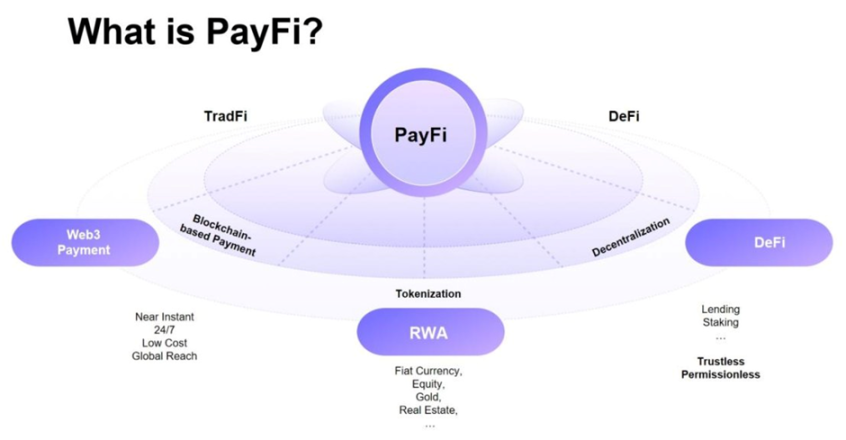
https://www.feixiaohao.com/news/12951184.html
The two core concepts that PayFi emphasizes are:
- Tokenization of Real World Assets: Since the essence of transaction payment scenarios is rooted in real life, the prerequisite for achieving PayFi is to move traditional payment scenarios onto the blockchain through tokenization. By utilizing stable, low-risk assets for initial tokenization, and leveraging DeFi to achieve transparency, high liquidity, diverse applications, and high returns, while RWA provides a broader range of asset classes and stable anchoring sources of income.
- Unlocking the Time Value of Funds: Another crucial concept of PayFi is to realize the time value of funds in the most efficient way at relatively low costs through smart contracts and the centralized characteristics of blockchain. For example, users can manage and invest funds without intermediaries, with applications such as on-chain flash credit markets, installment payment systems, and automated investment strategies all aimed at reducing opportunity costs, allowing funds to quickly enter the market for reinvestment or other uses.
Here, we quantify the value created by PayFi through a basic mathematical model, focusing on the opportunity cost loss brought by the return on funds:
Let P be the prepayment amount, r be the interest rate, and assume that traditional cross-border payments take 3 days, while cryptocurrency payments take 3 minutes. We can calculate the opportunity costs in both scenarios:
Opportunity Cost (Traditional Payment) = P × r × 3
Opportunity Cost (Cryptocurrency Payment) = P × r × (3/1440)
The difference between the two is approximately the interest difference over 3 days. From our simple reasoning, we can conclude that the opportunity cost difference will become increasingly significant with larger prepayments and rising interest rates. Therefore, this efficiency improvement is particularly pronounced in high-frequency, large-value transactions, and in an environment of rising interest rates.
Choice of Public Chain for PayFi
As of now, multiple cryptocurrency payment projects have chosen to establish themselves on Solana. Currently, Solana has become the primary platform for PYUSD, with a market share of 64%, far exceeding Ethereum's 36%. Several stablecoins compliant with MiCA standards, such as EUROC and EURC, will also be launched in the Solana ecosystem.
So, why do both traditional finance and native crypto projects tend to develop on Solana? We analyzed and summarized the following key factors: high-performance public chain, capital liquidity, and talent mobility.
- High-Performance Public Chain: Solana's high performance is its core competitive advantage, with its recorded TPS ranking among the top in public chains. The consensus mechanism and low gas fees employed by Solana significantly enhance its performance compared to most Layer 2 solutions.
- Capital Liquidity: Solana's ecosystem has secured $61 billion in staked capital, with investments from top venture capital firms like a16z and Polychain Capital further boosting Solana's market confidence and competitiveness.
- Rich Application Ecosystem: Numerous consumer-facing applications, whether Sanctum debit cards, Helium SIM cards, or the official Solana phone, far exceed the application development of other public chains.
Most Layer 2 projects, such as Optimism, zkSync, and Lightning Network, as well as public chains like Polygon, the yet-to-launch Monad, and Aptos, all claim to have stronger TPS and scalability. However, according to website data, most L1 and L2's highest recorded TPS does not even reach a fraction of Solana's.
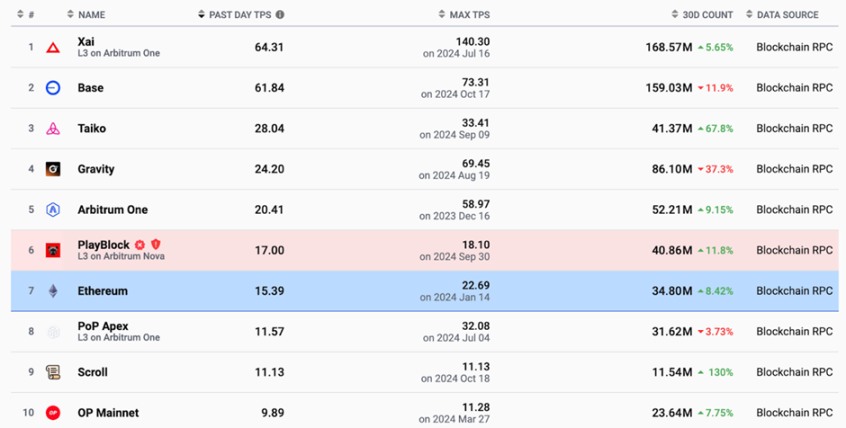
https://l2beat.com/scaling/activity
Although Solana has experienced multiple significant interruptions and security issues since its mainnet launch in 2020, ArkStream believes it will be challenging for any chain to fundamentally replace Solana in the short term. Here, we consider Sui and TON as two emerging public chains that are gradually demonstrating their unique advantages, providing more options for the future development of cryptocurrency payments.
Sui: Parallel Processing + Innovative Ecosystem
Sui, as a new generation public chain, adopts a DAG architecture and parallel processing. Unlike Solana's focus on high-frequency trading and DeFi, Sui emphasizes solving network bottlenecks in large-scale user interactions. This also explains why GameFi and more complex contracts may benefit from Sui's parallel computing capabilities and scalability.
Although Sui has not yet attracted large-scale capital like Solana, and its recorded peak TPS is less than half of Solana's, the development team behind it possesses rich experience in payment and decentralized application development, which may attract more innovative projects to develop within its ecosystem in the future. For PayFi, Sui's parallel processing capabilities may highlight advantages in applications with intensive user interactions.
TON: Community + Payment Bridge
TON originated from Telegram as a platform optimized for large-scale community communication and small, multiple payments. Unlike the technical paths of Sui and Solana, TON focuses on low latency and high scalability, with its sharding architecture capable of supporting a large number of small payment transactions, and it has been integrated into Telegram's user ecosystem.
TON's greatest potential lies in its vast user base, backed by 900 million monthly active users and integrated mini app features. As a bridge connecting Web2 and Web3, TON provides a massive ready-made market for payment projects like PayFi through social payments and micropayments.
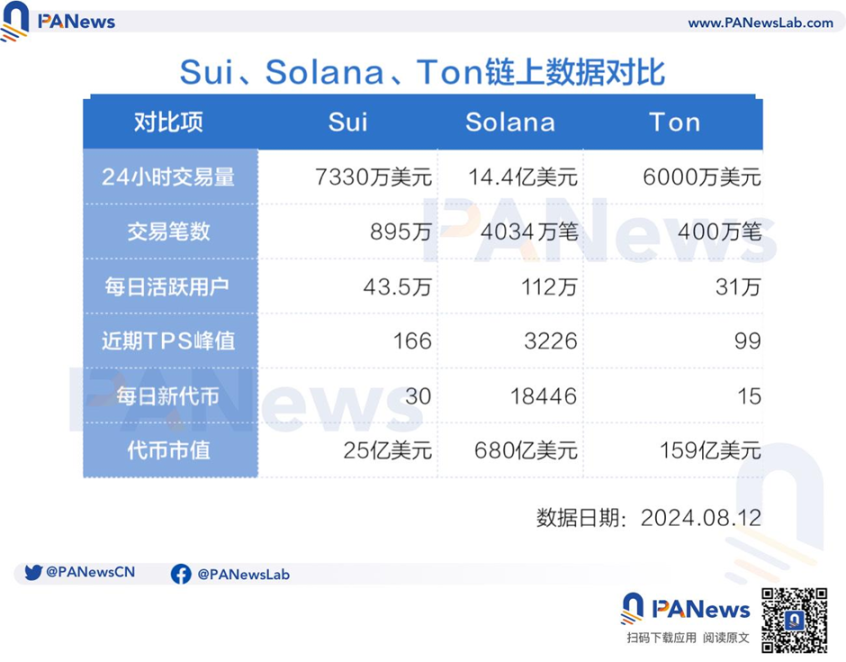
https://www.techflowpost.com/article/detail19707.html_
While Solana currently holds a leading position in the cryptocurrency payment market, including PayFi, due to its proven high performance, rich DeFi ecosystem, and capital advantages, the future of cryptocurrency payments may be characterized by multi-chain coexistence as technology continues to evolve. The parallel processing capabilities and innovative application scenarios of Sui, along with TON's extensive use in social payments, are expected to become key forces in breaking the existing cryptocurrency payment landscape.
Whether PayFi project teams will choose Sui or TON may ultimately depend on factors such as product requirements, market positioning, and GTM strategies, but the future richness of multi-chain and application scenarios undoubtedly provides more opportunities for PayFi projects.
Business Model and Practical Applications
The concept of PayFi was first proposed in April 2024, and there are currently few related projects. We categorize the projects we see in PayFi into two tracks, with the current application scenarios being: cross-border trade and credit finance.
Huma Finance
Product Introduction: Huma Finance is currently the focal point of the PayFi track, primarily targeting C-end users and small to medium enterprises with PayFi applications, and the recently acquired Arf mainly addresses the liquidity of prepaid capital in cross-border payments.
Arf's vision is to solve the liquidity and timeliness issues of prepaid capital in current cross-border payments. Through the Arf platform, trust issues between buyers and sellers are resolved without the need for traditional cross-border transaction requirements such as bank prepayments or letters of credit. Arf builds an on-chain liquidity network by providing peer-to-peer services, offering on-chain stablecoins to businesses in advance while eliminating the need for prepayments. When using Arf's services, businesses only need to pay the relevant fees and repay Arf within the agreed timeframe.
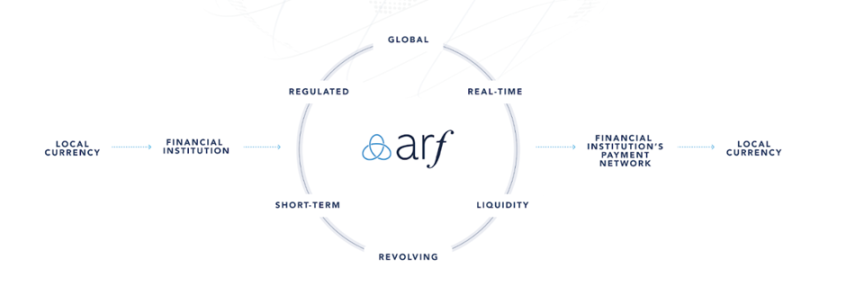
https://x.com/arfone_
At the same time, Huma Finance's main business revolves around the concept of "Buy Now, Pay Never," as claimed by Lily Liu. The core idea is that customers can choose to use their soon-to-mature accounts receivable as collateral. Huma tokenizes these receivables through its protocol, allowing customers to borrow from the loan pool, while the enforcement part is implemented by smart contracts on the chain. Its extendable space includes trade financing, micro-enterprise credit, international tuition payments, and more.
Technical Architecture: Huma Finance's PayFi Stack includes six layers: transaction layer, currency layer, custody layer, financing layer, compliance layer, and application layer, covering all levels from transaction processing to asset management, financing, and compliance. This full-stack design ensures that the entire process from loan application, asset assessment, fund provision to final payment can be completed within the same ecosystem. PayFi greatly simplifies the complex lending and payment processes through automation, decentralization, and multi-layered technical integration, enhancing efficiency and reducing costs.
Data Analysis: As of now, there is a total lending limit of $1 billion, with no records of defaults. Huma Finance, as a leader in the PayFi track, has raised $38 million.
Future Development Market for PayFi
After introducing the related projects of PayFi, we also contemplated the regional application scenarios. ArkStream believes that PayFi undoubtedly possesses the potential for global mass adoption, and its initial application scenarios may not necessarily be limited to developed countries (such as the United States, Singapore, Europe, etc.). We believe that emerging markets also have broad prospects.
- Market Strategy for Developed Countries: In developed countries, PayFi can leverage its integrated DeFi innovation capabilities to supplement existing digital payment systems. Due to clearer regulatory frameworks and policy support in developed countries, (such as USDC, PYUSD, EUROC) have been widely used in these regions. Finding a suitable entry point, such as collaborating with retailers, e-commerce, and cross-border financial platforms to build low-cost and more efficient cryptocurrency payment channels, may accelerate the opening of the PayFi market.
- Opportunities in Emerging Markets: At the same time, PayFi can provide services in areas lacking traditional financial services. By offering products like crypto microloans and flash loans, the decentralization and cross-border convenience of cryptocurrency payment systems can provide financial services to the "unbanked" population. For example, in regions like Africa, Southeast Asia, and Latin America, or in countries with high inflation currencies like Nigeria and Argentina. Because emerging markets lack complex traditional financial infrastructure, providing stable PayFi products may achieve scaling faster than in developed countries.
Therefore, ArkStream summarizes that PayFi should combine various market development strategies for a dual-track development: in developed countries, the focus should be on iterating existing application scenarios and establishing partnerships. In developing countries, it should promote the implementation of cryptocurrency payments and the penetration of PayFi into the cross-border remittance market.
Development Prospects
Although the concept of PayFi was proposed not long ago and practical application projects are relatively scarce, ArkStream believes that PayFi has a promising future development direction in the current environment. We see that both the development of cryptocurrency payment projects and the external economic environment are highly favorable for PayFi.
The global high-interest rate environment caused by the U.S. interest rate hikes in recent years has led to increased attention on bond products, and many users in the cryptocurrency market have shifted their funds into the tokenized bond market. Users value the stability of the underlying assets and their relatively high liquidity.
According to RWA.XYZ data, the market size of tokenized U.S. Treasury bonds has risen from $770 million at the beginning of 2024 to $1.916 billion as of August 1, 2024, an increase of 248%.
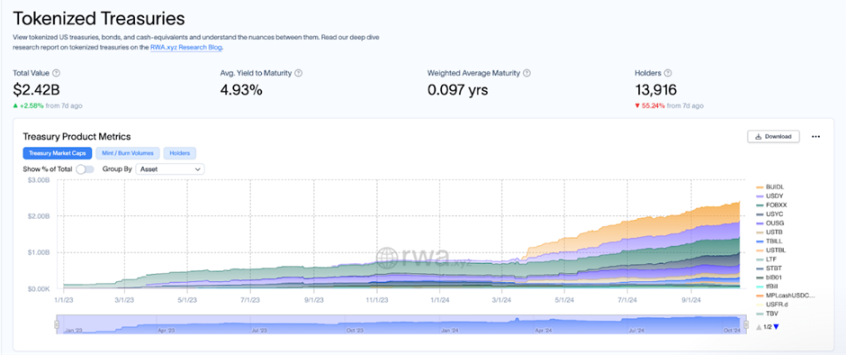
https://app.rwa.xyz/
With the U.S. announcing interest rate cuts and Treasury yields continuing to decline, investors' reliance on U.S. Treasuries is weakening, and this portion of funds needs to find the next scenario to invest in. Investors are turning to seek other assets with sustainable value and stable sources of income.
The rise of PayFi combined with the RWA model precisely fills this demand. Currently, the locked amount in the RWA track has reached $6 billion and continues to rise. The essence of RWA is to transport real-world assets (such as bonds, accounts receivable, supply chain financial assets, etc.) onto the chain through tokenization, providing investors with diverse choices while achieving higher liquidity for the assets.
Here we provide three potential RWA targets:
- MakerDAO RWA offers traditional assets such as real estate and accounts receivable, effectively connecting off-chain funding needs with on-chain liquidity through the DAI stablecoin issued by MakerDAO. It is currently the top-ranked RWA protocol by TVL.
- Tether Gold provides traditional tokens linked to gold, allowing investors to invest in gold through cryptocurrency without needing to hold physical gold directly.
- Ondo Finance offers risk-tiered government bonds, corporate bonds, and other real financial assets on-chain, allowing funds to be invested according to risk preferences. In the context of declining government bond yields, RWA products such as corporate loans provided by Ondo may better align with investors' preferences.
Conclusion
Currently, the number of projects related to the PayFi track is extremely limited, and most are still in the early stages of development. Therefore, we pay more attention to the innovation of PayFi project solutions.
From a business model perspective, PayFi combines multiple tracks such as cryptocurrency payments (e.g., Ripple, Stellar), DeFi lending (e.g., AAVE, Compound), and RWA (e.g., MakerDAO RWA, Ondo Finance). Projects in these areas have successfully validated the feasibility of their business models, demonstrating market demand and growth potential. By horizontally referencing the market capitalization of these tracks, PayFi, as a composite innovative business model, may have greater development space. Considering that leading projects in cryptocurrency payments, credit financing, and RWA have market capitalizations reaching billions to hundreds of billions of dollars, we have reason to speculate that as cross-border payments, supply chain finance, corporate financing, and other scenarios are unlocked and layered, the overall market capitalization of the PayFi track may even break this upper limit.
From a product dimension, future PayFi project development should focus on segmenting payment scenarios and optimizing efficiency and experience in these areas. Undoubtedly, PayFi is one of the few remaining blue ocean markets today, but this track currently lacks a large number of application projects. We call for more developers to utilize existing cryptocurrency payment technologies, focus on global markets, and innovate based on the actual needs of real life.
For example, at this year's Token2049 conference, we noticed the collaboration between TADA and the Ton network, which reduced the commission rates of ride-hailing software through cryptocurrency payments and profit-sharing, allowing it to stand out among similar ride-hailing platforms. We also noted that Ether.Fi is developing a cryptocurrency payment card business, where its Cash service not only has the functions of traditional cryptocurrency payment application scenarios, such as depositing cryptocurrency assets for consumption, but also allows users to use the income from liquid staking to repay their consumption expenditures.
These breakthroughs in real-world scenarios represent the immense potential that PayFi can reference globally. Project teams should not only focus on finding the next high-yield "reservoir" for on-chain funds but should pay more attention to how to let users in traditional industries experience the convenience of PayFi, thereby further enhancing the penetration of the cryptocurrency market from altruistic perspectives such as pricing and products.
It is easy to imagine that many new financial products, which are difficult to achieve within traditional financial systems, will emerge in the future, such as:
- Instant Lending: By collateralizing crypto assets on the PayFi platform, users can obtain loans that are more advantageous than those from traditional financial channels;
- Advance Consumption and Investment: Without incurring debt, users can consume or invest in advance before their future income cycle arrives;
- High-Yield Liquid Funds: By utilizing staking and liquid staking, users can enjoy high yields of over 10% while retaining the liquidity of their funds;
- Advance Payment of Interest on Locked Financial Products: Users can use interest as working capital before the financial product matures.
These innovative products leverage the core idea that "time is money." By maximizing the value of time, we clearly recognize that PayFi is not a castle in the air, nor just a "celebration for insiders." From both practicality and innovation perspectives, PayFi is gradually paving the way for the integration of cryptocurrency and traditional finance. As a long-term investor, ArkStream sees the potential of PayFi and even envisions a future without banks.
The innovative combination of these application scenarios meets the demands of DeFi and real-world applications, further validating PayFi's immense potential in releasing capital efficiency. ArkStream believes that the long-term application prospects of PayFi are limitless.
Reference
https://visaonchainanalytics.com/
https://defillama.com/stablecoins
https://www.galaxy.com/insights/perspectives/the-future-of-payments/
https://usa.visa.com/solutions/crypto/deep-dive-on-solana.html
https://usa.visa.com/solutions/crypto/deep-dive-on-solana.html
https://www.explinks.com/blog/web3-payment-research-report/
https://alexablockchain.com/alchemy-pay-to-transform-crypto-payment-with-its-new-product/
https://www.feixiaohao.com/news/12951184.html
https://l2beat.com/scaling/activity
https://www.techflowpost.com/article/detail_19707.html
https://x.com/arf_one
https://app.rwa.xyz/treasuries
免责声明:本文章仅代表作者个人观点,不代表本平台的立场和观点。本文章仅供信息分享,不构成对任何人的任何投资建议。用户与作者之间的任何争议,与本平台无关。如网页中刊载的文章或图片涉及侵权,请提供相关的权利证明和身份证明发送邮件到support@aicoin.com,本平台相关工作人员将会进行核查。




